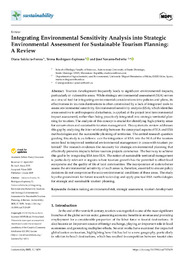Por favor, use este identificador para citar o enlazar este ítem:
https://hdl.handle.net/11000/37836Registro completo de metadatos
| Campo DC | Valor | Lengua/Idioma |
|---|---|---|
| dc.contributor.author | Salciccia-Frezza, Diana | - |
| dc.contributor.author | Rodríguez-Espinosa, Teresa | - |
| dc.contributor.author | Navarro-Pedreño, José | - |
| dc.contributor.other | Departamentos de la UMH::Agroquímica y Medio Ambiente | es_ES |
| dc.date.accessioned | 2025-11-04T09:38:08Z | - |
| dc.date.available | 2025-11-04T09:38:08Z | - |
| dc.date.created | 2025-06-12 | - |
| dc.identifier.citation | Sustainability 2025, 17(12) | es_ES |
| dc.identifier.issn | 2071-1050 | - |
| dc.identifier.uri | https://hdl.handle.net/11000/37836 | - |
| dc.description.abstract | Tourism development frequently leads to significant environmental impacts, particularly in vulnerable areas. While strategic environmental assessment (SEA) serves as a crucial tool for integrating environmental considerations into policies and plans, its effectiveness in tourism destinations is often constrained by a lack of integrated tools to assess environmental sensitivity. Environmental sensitivity analysis (ESA), which identifies areas sensitive to anthropogenic disturbance, is applied at the project level (environmental impact assessment), rather than being proactively integrated into strategic territorial planning for tourism. The analysis of this concept is crucial for identifying high-priority areas for conservation and sustainable tourism management. This systematic review addresses this gap by analyzing the inter-relationship between the conceptual aspects of SEA and ESA methodologies and the sustainable planning of territories. The central research question guiding this study is as follows: can the integration of ESA into the SEA of the tourism sector lead to improved territorial environmental management in areas with tourism potential? The research evidences the necessity for strategic environmental planning that effectively prevents impacts before tourism projects commence. The best way to achieve this goal is by integrating ESA into SEA. The notion of sustainable territorial management is particularly relevant in regions where tourism growth has the potential to affect local ecosystems and the quality of life of local communities. The incorporation of tools to better assess the environmental sensitivity of such areas is, therefore, essential to ensure policy decisions do not compromise the socio-environmental conditions of these areas. The study lays the groundwork for future research to develop and apply practical ESA methodologies for strategic and sustainable tourism planning. | es_ES |
| dc.format | application/pdf | es_ES |
| dc.format.extent | 23 | es_ES |
| dc.language.iso | eng | es_ES |
| dc.publisher | MDPI | es_ES |
| dc.rights | info:eu-repo/semantics/openAccess | es_ES |
| dc.rights | Attribution-NonCommercial-NoDerivatives 4.0 Internacional | * |
| dc.rights.uri | http://creativecommons.org/licenses/by-nc-nd/4.0/ | * |
| dc.subject | decision making | es_ES |
| dc.subject | environmental risk | es_ES |
| dc.subject | strategic assessment | es_ES |
| dc.subject | tourism development | es_ES |
| dc.subject.other | CDU::5 - Ciencias puras y naturales | es_ES |
| dc.title | Integrating Environmental Sensitivity Analysis into Strategic Environmental Assessment for Sustainable Tourism Planning: A Review | es_ES |
| dc.type | info:eu-repo/semantics/article | es_ES |
| dc.relation.publisherversion | https://doi.org/10.3390/su17125439 | es_ES |

Ver/Abrir:
sustainability-17-05439-v2.pdf
1,05 MB
Adobe PDF
Compartir:
 La licencia se describe como: Atribución-NonComercial-NoDerivada 4.0 Internacional.
La licencia se describe como: Atribución-NonComercial-NoDerivada 4.0 Internacional.
.png)